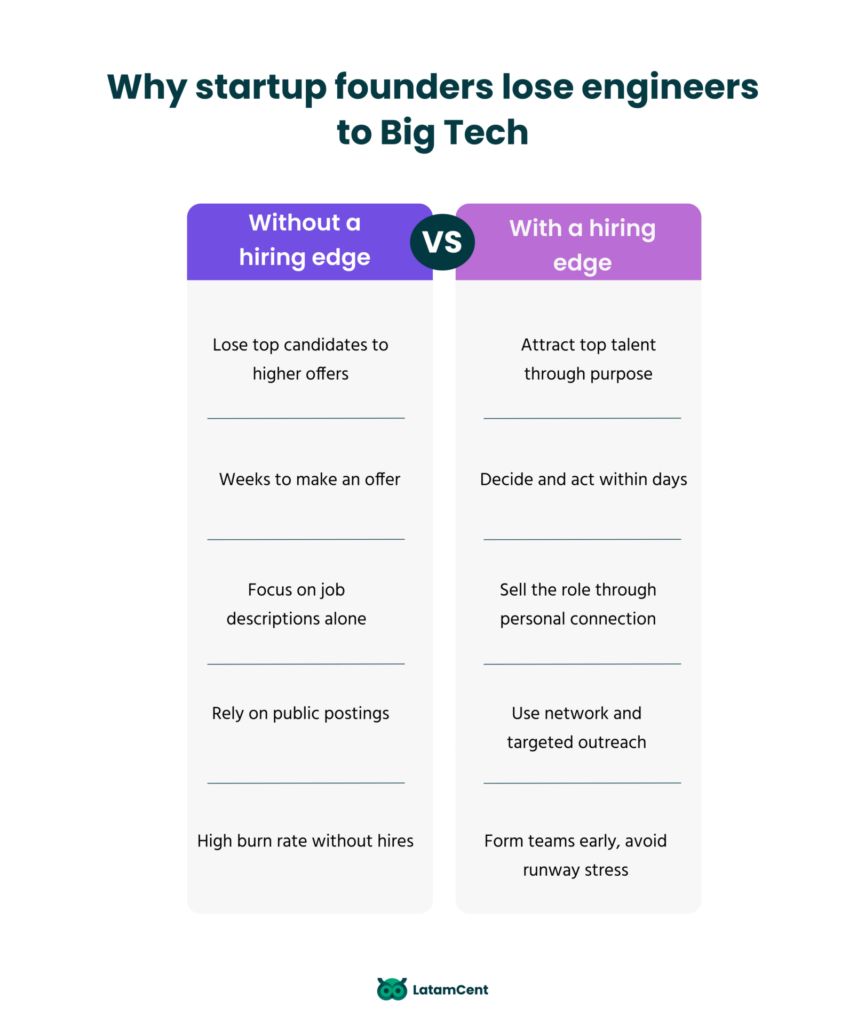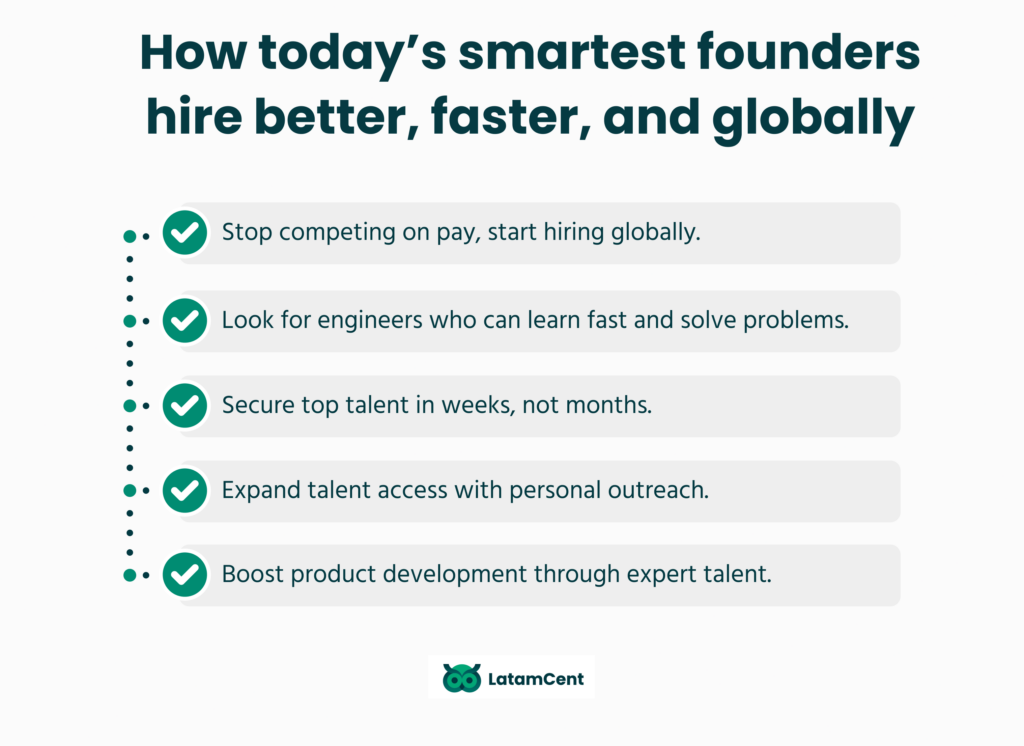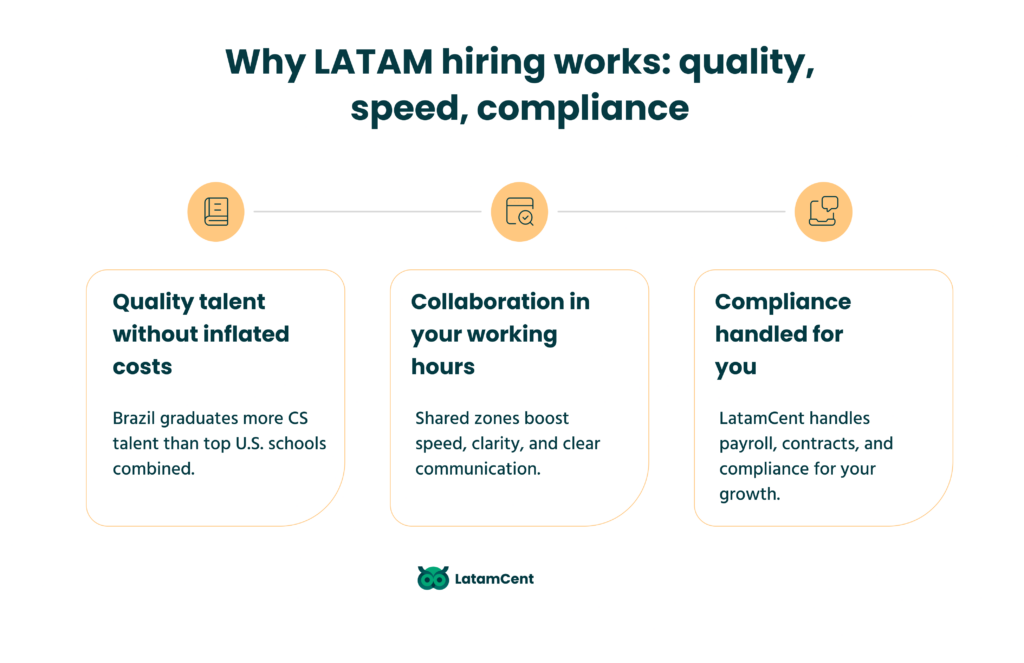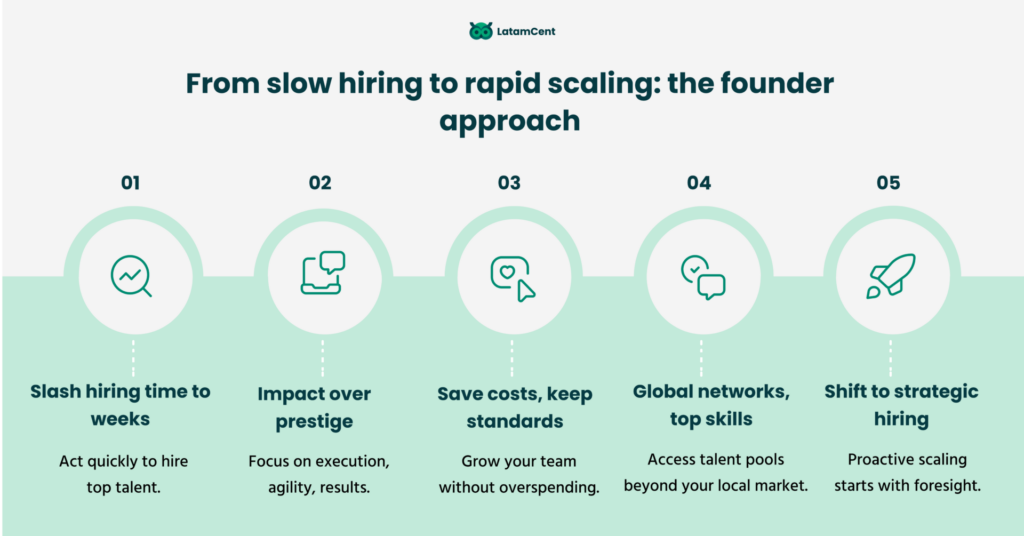It’s 2:47 a.m. and you’re still refreshing LinkedIn, wondering if hiring in this environment is just impossible especially when you’re up against big tech for every candidate.
Startup hiring presents a unique challenge compared to traditional hiring, as the competitive landscape demands a different approach to attract and retain top talent.
That senior software engineer you’ve been chasing for six weeks? Gone. Snatched up by Google. Big Tech had enough money to lock them down before you even wrapped another hiring meeting. The competitive nature of the startup ecosystem only intensifies the challenge of hiring top engineers, as every founder is fighting for the same limited pool of talent.
Even if you are OpenAI, you spent millions recruiting and building your team, just to get Zucked. Meta has been making “giant offers” to OpenAI staffers with “$100 million signing bonuses and poaching top talent from Sam Altman.
Meanwhile, your runway is burning at $150K+ a month. Your technical co founder the product-focused partner every startup world success story seems to have is asking when you’ll hire people to fill that empty desk, and how you’re balancing engineering work with management.
The guy you thought would join after that coffee meeting? Nowhere to be found. Those last three great engineers you thought were a done deal? Vanished, like half the Bay Area talent pool the second a higher salary comes along.

Next Tuesday’s board meeting.
The deck is ready except for one glaring gap: the engineering hire you promised would be done “by end of Q1.” It’s month four.
Your investors want answers. Why are you spending $80K on recruiting agencies when many startups in the startup world manage to bring in top talent through their own hiring process? Does this align with your company’s priorities, funding strategy, and overall business plan? It’s crucial to have a clear hiring strategy to ensure your hiring efforts support these objectives.
In the startup environment, hiring delays can derail product roadmaps, slow down engineering output, and damage your ability to attract investors.
Meanwhile, you’re burning $1.5M annually on salaries and still can’t ship the AI features your competitor rolled out last month. In the tech industry, that kind of delay isn’t just costly it’s often the difference between success and irrelevance.
Smart Founders Figured Out Something Different
While most tech companies keep fighting over the same overpriced Bay Area engineers, the smartest founders and their co founders stopped playing that game.
They’re not hiring in Silicon Valley anymore. They’re hiring like the original Silicon Valley founders before the market went insane.
The difference? Early founders optimized for speed, scrappiness, and global talent. They hired smart people who could adapt fast, master new skills, and learn engineering or marketing fundamentals when needed not just tick boxes for “years of experience.”
Silicon Valley’s edge was never the ZIP code. It was the founder mindset: leveraging every network, every opportunity, and every bit of technology to build a great product quickly.
And that mindset? It’s a perfect match for Latin America’s deep talent pools, especially when U.S. hiring cycles drag for 5+ months, costs keep climbing, and ghosting rates hit record highs. In startups, diverse ideas and backgrounds often outperform traditional credentials, building teams that can compete on the world stage.
Having access to matter-specific expertise in your network means you can solve complex problems faster, accelerate execution, and figure out technical solutions before competitors do. Building remote teams enables founders to tap into a wider range of skills and accelerate product development by leveraging talent from across the globe.

You’re Hiring Like a Corporation, Not a Founder
| Founder Playbook | Corporate HR Playbook |
|---|---|
| Direct outreach, GitHub scouting, referral networks | Job boards, ATS filters, recruiters |
| Hire for ownership, curiosity, and technical fundamentals | Hire for credentials and years of experience |
| Offers in days once talent is spotted | Average 5.4 months from req to start date |
| Vision-first narrative before salary | Standardized JD and comp ranges |
| Trade perfection for velocity | Perfect skill match, low training burden |
One idea gaining traction in the startup world is to use innovative approaches from coding challenges to real-world engineering projects to assess candidates. Going beyond traditional resumes can uncover top talent in your talent pool who might never get past a keyword filter.
Early founders from Shopify, Airbnb, and Notion famously recruited great engineers not with inflated salaries, but with equity, mission, and direct founder or co founder contact. In startups, especially before formal HR teams exist, the technical co-founder often drives the hiring process. They ensure technical skills align with the company’s product vision a difference that can make or break early success.
This role becomes even more critical when the rest of the team comes from other industries or non-technical backgrounds, since someone needs to figure out whether a candidate can actually ship a great product.
They understood something vital: top talent wants to build something meaningful, not just collect another paycheck. In a small company, hiring and management are intertwined, with founders shifting from hands-on engineering or technology work into broader business leadership. That transition is full of high-stakes deals, gut calls, and moments where you guess without perfect data.
Get it right, and you’ve hired the person who can deliver breakthrough technology. Get it wrong, and you’ve stalled momentum when every week counts.
The Numbers Don’t Lie: You’re Getting Crushed
Your current reality:
76% of SaaS companies struggle to fill engineering roles
Average time-to-hire: 5.4 months (up from 4.7 months in 2023)
44% of candidates ghost employers during the process
Engineering salary inflation: 25% annually in major markets, driven by high costs in places like San Francisco and Silicon Valley
Senior engineer total cost: $377K fully-loaded in San Francisco
What this costs you:
$680-$1,200 per day for every empty engineering seat making it critical to have enough money to keep those seats filled and avoid costly delays
40-60% of founder time spent on hiring instead of building
Product roadmap delays while competitors ship faster; you need to figure out the true cost of hiring delays and empty seats to make informed decisions
Board meeting pressure about burn rate vs. hiring velocity, especially when funding is on the line and investors expect rapid progress
A slow or inefficient engineering pipeline can make these problems worse, causing bottlenecks that lead to missed opportunities and further delays.
But there is always another way to solve problems.
The LATAM Founder Advantage
Same Quality, Founder Speed, 60% Savings
The talent reality:
≈ 2 million developers across Brazil, Mexico, Colombia, Argentina & Chile
220K new STEM graduates annually entering the market
Brazil, Mexico & Chile rank top-15 globally for tech skills (Coursera 2024)
Ex-FAANG talent routinely available at founder-friendly rates
Data integration specialist is increasingly recognized as a source for top talent, with companies actively competing to attract the best engineers and specialists from the region.
Many successful tech startups are now leveraging discover talent, as the region becomes a hub for tech startups seeking growth and cost advantages within the global startup ecosystem.
The collaboration reality:
Mexico City: 100% EST overlap, 80% PST overlap
Colombia/Peru: 100% EST overlap, 80% PST overlap
Brazil: 80% EST overlap, 60% PST overlap
The speed reality:
Founder-led LATAM hiring: 21 days or less from opening to signed offer
Your current process: 52-61 days average time-to-hire
The cost reality:
| Role | San Francisco | Mexico City | São Paulo |
|---|---|---|---|
| Senior Engineer (fully-loaded) | $377K | $82K | $91K |
| Sales Rep (OTE) | $280K | $65K | $72K |
| Customer Success Manager | $185K | $45K | $52K |
| Savings | Baseline | 75% less | 73% less |
Translation: Whether you need senior engineers, sales reps, or customer success managers three LATAM professionals costs less than one Bay Area hire, and the pay differences in compensation make it possible to attract high performers at a fraction of U.S. costs.
And the results speak for themselves:
One SaaS client saw 65% EBITDA improvement after building their LATAM team
Another reduced overhead costs by 51% while improving close rates
100% of companies expand their LATAM hiring after the first successful placement, recognizing that making a deal to secure LATAM talent is a strategic investment in the company’s growth.
Companies are efficiently scaling teams by tapping into LATAM talent, enabling rapid growth while maintaining quality and cost advantages.
But What About Quality / Communication / Legal Compliance?
I hear you thinking:“This sounds too good to be true. What’s the catch?”
💻 Quality concerns? Brazil alone produces more computer science graduates annually than Stanford, MIT, and Carnegie Mellon combined. You’re not getting “cheap labor” you’re getting founder-quality talent at founder-friendly prices. LATAM front-end engineers often bring unique insight to problem-solving, communicating complex technical concepts clearly and surfacing talent that goes beyond surface-level qualifications.
☎️ Communication fears? LATAM’s time zone overlap means your team meetings, daily standups, and blocker discussions happen during normal working hours no more 3 a.m. calls. McKinsey’s research shows teams with substantial time zone overlap resolve blockers 4x faster than those with minimal overlap. These engineers can talk through complex engineering or tech issues clearly, enabling your co founders, management, and investors to make faster decisions.
📑 Legal complexity? This is why services like LatamCent exist to handle the compliance, payroll, and legal framework so you can focus on what founders do best: building and scaling. Ensuring compliance in all company matters is crucial, and these services help you navigate the legal landscape with confidence.

Lead or Follow
Option 1: Keep fighting for average hires in a broken startup world talent market. Burn through months and millions while competitors gain ground. Try to explain to your board why that critical engineering job is still open after 6 months.
Big tech companies in Silicon Valley and the Bay Area are setting the pace for aggressive hiring, and other industries are copying their process to lock in top talent. This has turned hiring into a talent acquisition race, forcing startups to rethink their approach if they want to compete.
Meanwhile, you’re stuck competing for the same engineers, paying premium rates, and still getting the wrong person for the role.
Option 2: Start hiring like the founders and co founders who are already winning. Startups leading the way in global hiring are pulling in smart people from every talent pool on the world stage. They leverage agility, technology, and innovative ideas to attract and retain top talent.
Yes, you may have to argue your case to investors or management, but marketing your team to candidates is just as critical as marketing your great product to customers. In business, this difference is what drives success: focus on building the team that can deliver the impossible and deal with market changes faster than the competition.
Adopting the founder playbook isn’t just smart, it makes sense if you want to compete on the world stage.
The evidence is overwhelming:
Sequoia invested $4 billion in LATAM in 2023 alone
Hundreds of Y Combinator founders use remote-first LATAM hiring
U.S. companies hiring in LATAM grew 156% year-over-year in 2023
Your competitors are still posting jobs on the same boards, interviewing the same candidates, and burning the same runway.
Meanwhile, you could be building unstoppable teams across borders, impacting the world with your hiring strategy.
The Founder Playbook You Can Implement Today
🚫 Stop optimizing for: Process, prestige, and proximity
✅ Start optimizing for: Speed, leverage, and global talent
🚫 Stop hiring based on: ZIP codes and brand names
✅ Start hiring based on: Impact and execution speed
🚫 Stop burning: 5.4 months per hire following old-school HR playbooks
✅ Start filling: Senior roles in 23 days using global networks
Your next engineering hire could ship in 21 days instead of 61. Imagine the money saved and the momentum your team could gain with faster hiring cycles.
Your GTM team could be closing deals while competitors are still posting job descriptions. Your burn rate could drop by 50% without sacrificing quality freeing up investment for technology, marketing, or that impossible product launch your founders have been planning.
Learning how to hire the right person isn’t just about speed it’s about focus. Taking a course or workshop on hiring and management can sharpen the skills that keep things from going wrong.
As a co founder, building a strong team means looking for smart people with both technical chops and the stuff that makes a great product: ownership, adaptability, and diverse experiences. The point of adopting the founder playbook is to improve life for both founders and teams while competing in the startup world.
For folks considering the switch, remember that Silicon Valley wasn’t built on tradition it was built on speed, ideas, and risk-taking. Leveraging new technology in your hiring process can surface top talent anywhere. Stick to the old way, and you might lose the guy who could have been your next breakout engineer maybe to Google or another Bay Area startup.
The founder playbook is proven. Startup founders who embrace these hiring strategies consistently outperform their competitors.
The talent pool is waiting. Zero upfront risk, massive future upside. Will you implement this before your competition figures it out?

Ready to hire like a founder? Start building your LATAM team today →



